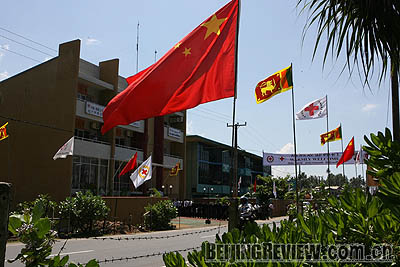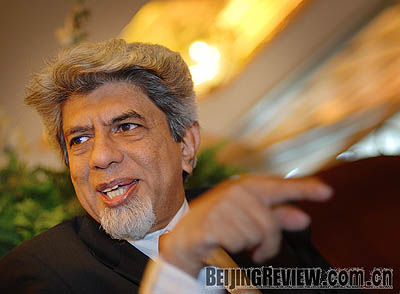|

FROM CHINA: A Chinese flag flies in front of the new office building of the Galle branch of the Sri Lanka Red Cross Society. The complex was built as part of China’s efforts to help reconstruct tsunami-stricken areas in Sri Lanka
CHEN ZHANJIE
At a recent conference in Beijing, scholars and officials explored the potential for collaboration between China and the South Asian Association for Regional Cooperation (SAARC) and came up with a number of proposals for the governments to consider.
SAARC, a major regional cooperation organization in South Asia founded in 1985, groups India, Pakistan, Bangladesh, Sri Lanka, Nepal, Bhutan, Maldives and Afghanistan. China became an observer of the organization in 2006 and attended its 14th summit in New Delhi in 2007. The 15th SAARC Summit is scheduled on August 2-3 in Colombo, Sri Lanka.
Nihal Rodrigo, an advisor to the president of Sri Lanka on foreign affairs, talked to Beijing Review reporter Yan Wei about China's ties with South Asia as well as some highly charged issues. He was in Beijing for the conference on China-SAARC cooperation as former Sri Lankan ambassador to China and former secretary general of SAARC.
Beijing Review: What role can China play in SAARC as an observer of the organization?
Nihal Rodrigo: This is the issue that brought me to China. We had a conference on April 19-20 organized by the China Institute of International Studies and Sri Lanka's Bandaranaike Center for International Studies. We invited all the SAARC countries to send representatives. The interactive discussions between Chinese and South Asian participants were fruitful. The participants were mostly academics, but almost everybody present, at some time or other, worked in the government. We looked at how each SAARC country has developed bilateral relations with China. All of us studied different ways, in which China can cooperate with SAARC as a regional association. We came up with some informal proposals, which will be submitted to be considered by our governments. We have recommendations on poverty alleviation exchanges, project-based cooperation in infrastructure development, power and energy, as well as exchanges in technical cooperation. The SAARC Development Fund is open to observers. We welcome Chinese contributions to the fund. Balanced trade is also to be encouraged. I think once political decisions are taken, we will be able to start.
Chinese President Hu Jintao told Sri Lankan President Mahinda Rajapaksa at the Boao Forum for Asia in early April that China would send a high representative to the SAARC Summit in Colombo in August.
China believes that South Asia is an important destination for its overseas investment. What is SAARC's attitude toward Chinese investment in the region?

“With greater coordination within SAARC and closer linkages with China, Japan and South Korea, and of course ASEAN, Asia will obviously have great chances to give practical content and economic meaning to the ‘Asian Century.’”
--Nihal Rodrigo
We welcome Chinese investment in South Asia. Potential areas for investment in South Asia are being studied. In Sri Lanka, Chinese investment is mainly in the fields of construction and infrastructure. The investment covers loans, investing directly and providing technology. We have two big projects. One is development of Hambantota, a port in south Sri Lanka and oil refinery and storage facilities and infrastructure in the area. It is a win-win situation, because Chinese ships can pass through there to the Middle East and Africa. The other one is an electricity-generating project.
What are the potential areas for Chinese investment?
Tourism is also a very important area. In the last two years, the number of Chinese tourists coming to Sri Lanka was more than the Japanese. Sri Lankan Airlines operates three flights a week between Colombo
| 